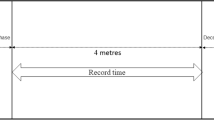Summary
This report deals with the analysis of data from a 3-year clinical trial on the effect of walking on postmenopausal bone loss. Two hundred fifty-five women, with an average age of 57 at entry, were randomized into two groups, a walking and a control group. Bone measures in the shaft of the radius were carried out with a CT scanner in search of generalized skeletal effects rather than effects localized to the bones of the leg. Although bone density losses were comparable in the two randomized groups, changes in the crosssectional area of the radius were significantly greater in the walkers with high grip strength (>25 Kg) than in the controls with comparable high grip strength which corresponded to the upper half range of the grip-strength distribution. It is concluded that the moderate activity of walking exerted systemically positive effects on the radius which, within the protocol of the study, could be substantiated only when synergized with inherent muscle strength.
Similar content being viewed by others
References
Smith DM, Khairi MRA, Johnston CC Jr (1975) The loss of bone mineral with aging and its relationship to risk of fracture. J Clin Invest 56:311–318
Riggs BL, Wahner HW, Dunn WL, Mazess RB, Offord KP, Melton LJ III (1981) Differential changes in bone mineral density of the apendicular and axial skeleton with aging. J Clin Invest 67:328–335
Mazess RB, Cameron JR (1973) Bone mineral content in normal US whites. In: RB Mazess (ed) Proc Int Conf on Bone Mineral Measurement, US Govt Printing Office, Washington, DC, 228
Cohn SH, Vaswani A, Zanzi I, Ellis KJ (1976) Effect of aging on bone mass in adult women. Am J Physiol 230:143–148
Mazess RB (1980) The non-invasive measurement of skeletal mass. In: WA Peck (ed) Bone and mineral research annual I. Excerpta Medica, Amsterdam, 223–279
Cann CE, Genant HK (1980) Precise measurement of vertebral mineral content using computed tomography. J Comput Assist Tomog 4(4): 493–500
Cohn SH (1982) Techniques for determining the efficacy of treatment of osteoporosis. Calcif Tissue Int 34:433–438
Singh M, Riggs BL, Beabout JW, Jowsey J (1972) Femoral trabecular-pattern index for evaluation of spinal osteoporosis. Ann Intern Med 77:63–67
Hayes WC, Gerhart TN (1985) Biomechanics of bone: applications for assessment of bone strength. In: NA Peck (ed) bone and mineral research. Elsevier Science BV, New York, 259–294
Avioli LV (1982) Aging, bone and osteoporosis. In: SG Korenman (ed) Endocrine aspects of aging. Elsevier Biomedical, New York, Amsterdam, Oxford, 199–230
Riggs BL, Wahner HW, Seeman E, Offord KP, Dunn WL, Mazess RB, Johnson KA, Melton LJ, III (1982) Changes in bone mineral density of the proximal femur and spine with aging: differences between the postmenopausal and senile osteoporosis syndrome. J Clin Invest 70:716–723
Cummings SR (1985) Are patients with hip fracture more osteoporotic? Am J Med 78:487–494
Frost HM (1985) The pathomechanics of osteoporosis. Clin Orthop 200:198–225
Ruff ChB, Hayes WC (1970) Subperiosteal expansion and cortical remodelling of the human femur and tibia with aging. Science 217(3):945–948
Garn SM (1970) The earlier gain and later loss of cortical bone. Charles C Thomas. Springield, Illinois
Paffenbarger GS, Wing AL, Hyde TR (1978) Physical activity as an index of heart attack risk in college alumni. Am J Epidemiol 108: 161–165
Cauley JA, LaPorte RE, Sandler RB, Schramm MM, Kriska AM (1987) Comparison of methods to measure physical activity in postmenopausal women. Am J Clin Nutr 45:14–22
LaPorte RE, Sandler RB, Cauley JA, Link M, Bayles C, Marks B (1983) The assessment of physical activity in older women: analysis of the interrelationship and reliability of activity monitoring, activity surveys, and caloric intake. J Gerontol 38:394–397
Goldsmith R, Hale T (1971) Relationship between habitual physical activity and physical fitness. Am J Clin Nutr 24:1489–1493
Sashin D, Sterglass EJ, Sandler RB, Slasky BS, LaPorte RE, Cauley J (1983) The development and evaluation of a CT technique for measurement of density of cortical bone in the appendicular skeleton. J Comput Assist Tomog 7(3):1
Sandler RB, LaPorte RE, Sashin D, Kuller L, Sternglass E, Cauley J, Link M (1982) Determinants of bone mass in menopause. Prev Med 11:269–280
Schlenker RA (1976) Percentages of cortical and trabecular bone mineral mass in the radius and ulna. Am J Roentgenol 126:1309–1312
Nie NH, Hall CH, Jenkins JG, Steinbrenner K, Bent DH (1975) Satistical package for the social sciences (SPSS), 2nd ed. Mc Graw-Hill, New York
US Dept of Health and Human Services (1980) The Lipid Research Clinics population studies data book. NIH Publication, Vol 1, Bethesda, Maryland, pp 80–1527
Cauley JA, Sandler RB, LaPorte RE, Kriska AM, Pambianco G, Sashin D (in press) Relationship of grip strength to radius bone density, bone area and bone loss in the menopause. Med Sci Sports Exer
Huddleston AL, Rockwell D, Kulund DN, Harrison RB (1980) Bone mass in lifetime tennis athletes, JAMA 244:1107–1109
Nilsson BE, Anderson SM, Havdrup T, Westlin NE (1985) Ballet dancing and weight-lifting-effects on bone mineral content. In: RB Mazess (ed) Fourth In Conf on Bone Measurement 541–552
McDonald R, Hegenauer J, Saltman P (1986) Age-related differences in the bone mineralization pattern of rats following exercise. J Gerontol 41:455–452
Melton LJ III, Riggs BL (1983) Epidemiology of age-related fractures. In: LV Avioli (ed) The osteoporotic sydrome. Grune & Stratton, New York, pp. 45–72
Ruff ChB, Hayes WC (1984) Bone mineral conent in the lower limb. J Bone Joint Surg 66A:1024–1031
Author information
Authors and Affiliations
Rights and permissions
About this article
Cite this article
Black Sandler, R., Cauley, J.A., Hom, D.L. et al. The effects of walking on the cross-sectional dimensions of the radius in postmenopausal women. Calcif Tissue Int 41, 65–69 (1987). https://doi.org/10.1007/BF02555246
Received:
Revised:
Issue Date:
DOI: https://doi.org/10.1007/BF02555246




